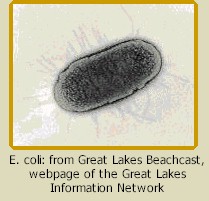|
BOB SIMONSON, Program Leader
QUANTIFYING FECAL COLIFORMS - ECOLI IN THE FIELD Kim Clarkin , Project Leader |
||

San Dimas Technology
& Development Center
444 E Bonita Ave
San Dimas, CA 91773
(909) 599-1267
| Incubators | QA/QC | Batteries & Inverters |
INTRODUCTION TO COLIFORMS, WATER QUALITY STANDARDS, AND ANALYSIS METHODS
What Are Coliforms?
 Coliform bacteria (total coliforms) are widespread in the enviroment--in soils, decaying vegetation, manure, and aquatic environments. Fecal Coliforms are a subgroup found in human or animal
intestines and feces, and some other areas of the enviroment. Fecal coliform bacteria in stream water generally indicate fecal contamination. Although fecals are not generally disease-causing themselves, their presence can indicate the potential presence of harmful pathogens from a fecal source. Certain types of fecal coliforms, such as pathogenic strains of E. coli, do cause gastrointestinal disease (see the US Food and Drug Administration's "Bad Bug Book" on the web).
Coliform bacteria (total coliforms) are widespread in the enviroment--in soils, decaying vegetation, manure, and aquatic environments. Fecal Coliforms are a subgroup found in human or animal
intestines and feces, and some other areas of the enviroment. Fecal coliform bacteria in stream water generally indicate fecal contamination. Although fecals are not generally disease-causing themselves, their presence can indicate the potential presence of harmful pathogens from a fecal source. Certain types of fecal coliforms, such as pathogenic strains of E. coli, do cause gastrointestinal disease (see the US Food and Drug Administration's "Bad Bug Book" on the web).
Counts of these organisms in stream water are important indicators of a stream's suitability for swimming and wading (contact recreation). For a general discussion of coliform sources and risks, see the EPA's webpage offering guidance for monitoring programs: http://wwww.epa.gov/owow/monitoring/volunteer/stream/vms511.html. The Washington State Citizen's Guide to Understanding and Monitoring Lakes and Streams, on the Department of Ecology website, also has good background information about coliforms.
All states regulate coliforms in surface waters and, at a minimum, National Forest streams are expected to meet water quality standards for contact recreation. These standards are referred to as ambient water quality standards for recreational waters to distinguish them from drinking water standards. Standards are usually set in terms of number of colony-forming units per 100 mL of water. Some states base their standards on total or fecal coliforms, some on E.coli, and some on enterococci, a non-coliform fecal bacterium that is able to survive in salt water.
Fecal coliforms as a group are no longer considered to be good indicators of fecal contamination in surface water because they are not exclusive to fecal material. Since 1986 EPA has recommended that States, Tribes, and Territories adopt E.coli and enterococci as better indicators (EPA 2000). Some states have made the switch; many have not.
EPA links to each state’s water quality requirements at: http://www.epa.gov/docs/epacfr40/find-aid.info/state/. This project did not include methods for enterococci analysis.
How do we measure coliforms in water?
EPA-approved methods for quantifying coliforms in ambient waters are listed in 40 CFR Part 136, first published in the Federal Register on 21 July 2003. For the regulations and updates, see EPA’s methods page: http://www.epa.gov/waterscience/methods/biological/index.html
Fecal coliforms grown on the lactose-based medium M-FC produce blue colonies. E.coli have an enzyme that reacts with the test substrate (MUG) to produce a fluorescent substance. Standard enumeration methods are based on these characteristics. Generally, testing involves growing the bacteria under the specified conditions, and either counting or estimating the number of colonies that form with specified characteristics.
EPA-approved methods for coliform analysis described in Standard Methods (APHA 1998, Part 9060B) require that ambient water samples be processed within 8 hours of the time they are collected. This is true for total coliforms, fecal coliform and E.coli analyses. In most methods, the processed samples need to be kept in an incubator for a certain period of time before the colonies are counted.
You will need to be very careful working with deep cycle marine batteries to power equipment in the field. It is very important to read carefully and follow the instructions that come with your battery and inverter. Never connect the battery to an appliance that is turned on.
Once the kit is completely assembled, try running some samples at base. This will familiarize you with the sample processing procedure and the equipment, and it will enable you to troubleshoot the power system before using it in the field.
Safety considerations specific to the field coliform analysis are included in the job hazard analysis. This JHA does not pretend to be complete, but it can serve as a starting point for you to develop your own.


